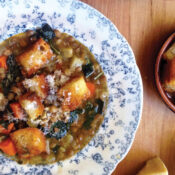In the second of four installments of the Wonderful World of Tea, we will take a look at the different forms in which we find the Camellia sinensis plant (there is more than you think- bet you didn’t know that there is a yellow tea). In theory, you could make at least six different types of tea from one of these multifaceted plants, and every one would have a different flavor. If you have ever wondered about the difference between black and green tea (besides its color, of course) or what exactly white tea is, the answers are right here.
Essentially, the color of tea leaves is determined by the way they are processed (for an overview of how tea is processed, see the Tea Basics page).
Black Tea– The most heavily fermented tea. Fermentation (or, more accurately, oxidation) darkens the color of tea, and black tea has been fermented to the point where all signs of the natural green color are gone. Black tea generally contains more caffeine than other teas, but that is not entirely because of the processing. Although fermentation makes the caffeine stronger, black tea is usually made from Assam, Darjeeling and other Indian tea plants, which contain more caffeine to start with. This has traditionally been the most popular tea in the western world, although green tea is catching up.
Green Tea– Tea that does not go through the fermentation process. Green tea is usually steamed immediately after it is rolled, a step that halts the oxidation process and allows the leaves to maintain their natural green color. Green tea is valued because less processing means more of the natural elements found in a live plant. It contains more antioxidants and certain vitamins and minerals than more heavily fermented tea.
White Tea– This is essentially “baby” tea. Harvested while the tea plant is still young, it is called “white” because the immature leaves are usually covered with fine white hair. White tea is ideal for those that need a morning jolt, because the youthful leaves contain a higher concentration of caffeine than older green leaves. Perhaps more importantly, white tea contains more polyphenols than any other tea. Polyphenols are an antioxidant thought to reduce the risk of cancer and other serious health problems.
Oolong– The middle ground between black and green tea. Oolong tea is “semi-fermented,” which means it undergoes 20% to 80% of the oxidation that black tea does. This semi-fermented state gives it the quality of both black and green teas. These clashing characteristics affect the taste of oolong, giving it a very distinctive flavor that is sometimes described as “funky.” Oolong is a popular tea to cook with. (Note: there is also a middle ground between oolong and green: Pouchong tea. It receives only 10-20% of the oxidation that black tea does, and is very similar to green.)

Yellow Tea- Perhaps the most mysterious tea, yellow tea has been virtually unknown outside of China until only recently. Its processing methods are as varied as the estates that produce it. One method consists of pan-frying and/or roasting it until it is about 70% dry. It is then rolled and fermented for several days before a final roasting. The fermentation time using this method is actually longer than that of black tea, but it is far less oxidized because of the pre-ferment firing. Other yellow teas are hardly fermented at all, but harvested and prepared in a manner unlike typical green or white teas. Proponents of yellow tea like it because it contains almost as many antioxidants as green tea with less of a “grassy” flavor.
Read More: The Wonderful World of Tea, Part 1: The Basics.
Sweet Iced Tea: An American Classic
Ingredients:
- 3 Family Sized Orange Pekoe Black Teabags
- 1 cup of sugar (or sweetener)
- 4 cups of water
- Lemon Juice
- Ice
Heat the water on the stove. When the water begins to boil, add teabags, turn stove off, cover, and let steep for five minutes. Remove bags and pour into a gallon pitcher. Add sugar and lemon juice to taste. Stir. Once the sugar is dissolved, fill the pitcher with ice and refrigerate.
Smoky Oolong Chicken Wings
- 3 Cloves Garlic
- 1 Tbsp. Ginger Root
- Soy Sauce (to taste)
- 16 Chicken Wings
- 1 Tbsp. Honey
- ¾ Cup Brown Sugar
- Sesame Seeds (garnish)
- 6 Green Onions, chopped
- 1 Cup Oolong Tealeaves
- Sesame Oil
- ½ cup Sherry
Place the garlic, onions, ginger, soy sauce, honey, and sherry in a blender. Blend for a short time period (about 15-20 seconds). Pour into a 9’x13’ baking pan. Add wings (make sure to coat them evenly). Set the pan in the fridge for 2 hours; rotate the wings after about an hour. Line a wok with heavy-duty aluminum and sprinkle the brown sugar and oolong on top of the foil. Put a wire rack in the wok, and put the wings on it. Cover and cook on high for about 30 minutes. Make sure to keep the wok covered for about 20 minutes after pan-frying, so the chicken can fully absorb the smoky oolong flavor. After 20 minutes, uncover and add sesame oil to taste. Finish by cooking wings in a preheated oven at 450 degrees for five minutes.
Special thanks to Tea’s Me Cafe, Indianapolis, Indiana.
Become a Saturday Evening Post member and enjoy unlimited access. Subscribe now



